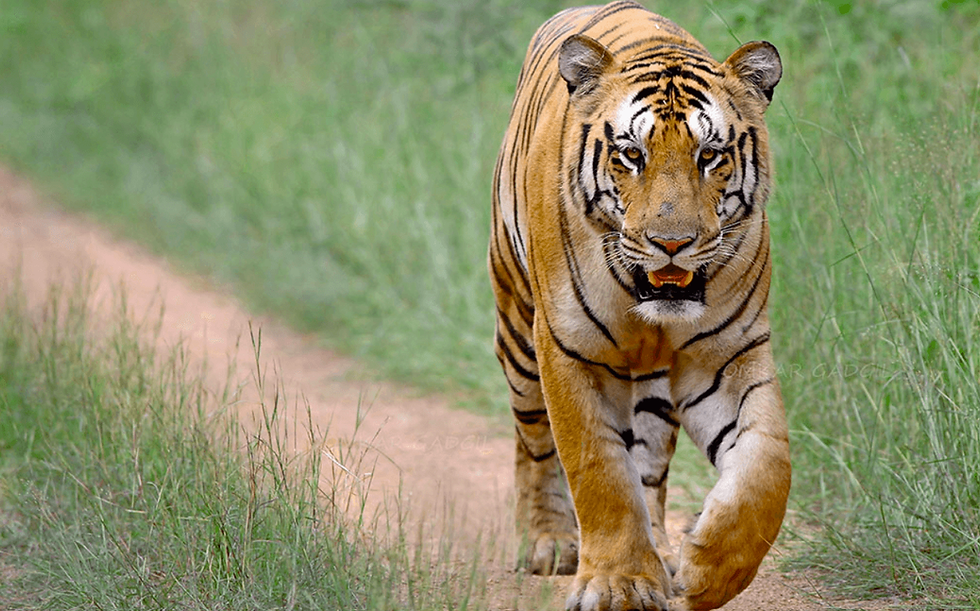Legendary Tigers of Vidarbha: Remarkable Stories from the Wild
- thenewsdirt

- Jul 1
- 7 min read

In Vidarbha region, tigers roam across several sanctuaries and reserves, inspiring both awe and concern.
Over the years, individual tigers there have risen to local fame for their size, tenacity or remarkable journeys. Jai, a massive male monitored around Nagpur, was widely regarded as “the most popular and iconic tiger of Vidarbha jungles”. In Chandrapur’s Tadoba-Andhari Tiger Reserve, others like Yeda Anna and Sonam have also held sway, earning reputations as dominant big cats.
These animals’ lives, marked by long-range treks, surprise encounters or sudden disappearances, have captured public imagination. Their individual stories shed light on tiger conservation in Vidarbha’s dense forests and the challenges of coexistence between people and wildlife.
Jai: Vidarbha’s Iconic Tiger

Jai (often called T1) became a symbol of Vidarbha’s forests. Named after Amitabh Bachchan’s character in Sholay, he wandered hundreds of kilometres across the Umred-Karhandla and Nagzira sanctuaries. Scientists estimated he had fathered more than 20 cubs during his life.
Jai was radio-collared by wildlife biologist Bilal Habib, though the signal was lost after a few months.
He became famous for both his massive size, weighing about 240 kg, and his bold presence in the Nagpur region.
When he went missing on April 18, 2016, it made headlines. Jai had long been “the pride of Nagpur jungles” and noted that wildlife lovers were already mourning the disappearance of “the most popular and iconic tiger of Vidarbha”.
By mid-2016, Jai had been gone for three months with no trace. Local activists launched a public search. They held hawan ceremonies and poster campaigns, and even offered rewards for information. The pressure grew so intense that people organised candlelight vigils and petition drives.
One campaigner later recalled that their group gathered about 13,000 signatures demanding answers about Jai’s fate.
Witness reports and photographs yielded no confirmed sightings. In interviews, some trackers openly said they believed Jai must be dead.
Conservationist Mohammad Junaid said, “I strongly feel Jai is already dead” – noting villagers’ fears – and even accused officials of trying “to cover up the news”. Another activist, Sarosh Lodhi, added that the state forestry department’s efforts to find Jai had been only “half-hearted”. At the same time, Pench reserve officials urged patience.
Field director M. S. Reddy insisted he had “no reason to believe that Jai’s dead,” pointing out that the tiger had many adult sons nearby who could attract the big cat to new territories. He cautioned that male tigers sometimes shift ranges, and “it happens all the time with tigers” that a dominant male vanishes from one park only to appear in another.
While these debates continued, the last confirmed data remained Jai’s April 2016 radio collar signal.
No further kills of cattle (a typical sign of Jai’s presence) were recorded in his usual 500–600 km² territory for months. By 2017, many supporters acknowledged he was likely gone. One newspaper account observed that after a year without signs of life, locals had “accepted that Jai is no longer alive,” even as authorities avoided any official declaration.
Jai’s case attracted national attention when Maharashtra declared 2017 a tourism promotion year, one activist pointed out on record the irony of urging wildlife tourism “when you can’t keep the king of the jungle safe”.
To this day, Jai’s disappearance remains a stark reminder of how even a heavily monitored tiger can vanish without closure.
From Father to Sons: Tracking UKWS Cubs
After Jai’s disappearance, researchers continued to monitor his known offspring. In early 2016, the Wildlife Institute of India (WII) had fitted collars on two of Jai’s subadult sons, T9 (Srinivas) and T10 (Bittu).
Over 12 months of intensive tracking, scientists charted their movements across Vidarbha’s fragmented landscape. This was a landmark study, one of the longest-ever tracking projects for juvenile tigers.
WII researcher Bilal Habib remarked that this was “the first time we have actually been able to track [the cubs’] journey for such a long period”. The results were striking. Both brothers left their natal Umred-Karhandla Wildlife Sanctuary (UKWS) and trekked into neighbouring Chandrapur district, settling in the Bramhapuri forest by early 2017.
On different paths, the two male siblings covered roughly 100 km to reach the same general area. The team noted that about 27 tigers were now in the non-protected corridor between UKWS and Bramhapuri – “perhaps the highest number for such an area anywhere”. This showed Vidarbha’s forests were heavily populated with big cats even outside the official reserves.
By this stage, Srinivas and Bittu had grown impressively. Each weighed about 230 kg, only slightly below their father’s 240 kg.
They were photographed mating with local tigresses, indicating they were ready to establish territories of their own.
Their parents’ genes ran deep; the mother (T3, nicknamed Fairy) and the lineage of Wagdoh and Madhuri (legendary tigers of Tadoba) were all present in their pedigree.
In explaining the project’s impact, Habib noted that tracking these cubs “shed light on how [they] take baby steps to survive in stressful territories dominated by humans and adult tigers”.
In other words, Bittu and Srinivas demonstrated how young tigers navigate a human-dominated landscape.
They sometimes stayed in one place only a few days, crossed roads or railways, and travelled where prey was available. Their endurance provided hope that new generations of tigers can disperse through and repopulate Vidarbha’s jungles, even if their father had vanished.
Champions of Tadoba: Yeda Anna and Sonam
Further south in Chandrapur district, Tadoba-Andhari Tiger Reserve has its own star cats.
One such individual was Yeda Anna, a male who patrolled the Tadoba core area. Yeda Anna gained fame for his tenacity and many offspring.
In February 2018, he had recently been found gravely injured near the sanctuary’s boundary. The 14-year-old tiger had fought with a younger male and broken his jaw and limbs. Deputy Conservator Kulraj Singh described the scene: the animal was “very old and weak” and died on the spot from its wounds. It was noted that Yeda Anna “fathered more than 30 cubs” during his life.
His death was a big event in local conservation circles, losing the previously dominant male was “a huge loss to the state,” said wildlife officials. On the ground, some blamed delayed tranquilisation efforts, but others simply saw it as the end of an old ruler’s era.
Tadoba’s tigress Sonam is another celebrated figure. She was born in the core zone and was often seen with her cubs around Tadoba’s lakes.
Sonam’s lineage is storied: she is the daughter of Wagdoh and Madhuri, a pair once dubbed Tadoba’s ‘Telia Tigers.’ By 2016, Sonam herself was about 14 years old but remained strong. Wildlife photographers frequently spotted her defending her territory at Telia Lake even as younger females began to crowd her edges.
At least three cubs from Sonam’s latest litter were documented, signalling her continued role in raising the park’s population. Though not as widely reported in the media as Jai or Yeda Anna, Sonam’s presence and that of her cubs exemplify the importance of female tigers in sustaining the future of Vidarbha’s tiger population.
Bajirao, King of Bor Wildlife Sanctuary

Outside the main tiger reserves, smaller forests in Vidarbha have their own legends. In Wardha district, Bor Wildlife Sanctuary was home to a well-known male called Bajirao.
In late 2017, a tiger was killed by a speeding truck on the NH-6 highway near Nagpur. Conservation groups quickly identified it as Bajirao, Bor’s dominant male.
The Wildlife Protection Society of India noted that “Bajirao was the most dominant male at Bor [Wildlife Sanctuary] ... and fathered eight to nine cubs”.
Field officers said he was about eight years old and had the largest territory in the area, spanning roughly 150 square kilometres from Bor up toward Kalmeshwar. Wildlife experts, including Anish Andheri,a called the death “a huge loss to the state,” since Bajirao had played a key role in the small park’s tiger population. The incident highlighted the risk posed by roads. Officials noted Bajirao had severe head and leg injuries consistent with a vehicle collision.
His loss reverberated among the local community of trackers, as it meant one less breeding male to ensure genetic diversity in Vidarbha’s network of sanctuaries.
The case of Bajirao contrasted with that of the protected reserves. No one saw him struggle or wander, his story ended in an instant on the highway. Yet in both instances (Jai in Nagpur’s forests, Bajirao on an open road), Vidarbha’s tigers underscored different facets of conservation.
In Bor, it prompted calls for better wildlife corridors and road-crossing structures. In Tadoba or UKWS, missing or injured great cats prompted public outcry and press coverage.
Each of these tigers ,Jai, Yeda Anna, Sonam, Bajirao, became a symbol in its own right. Their unique features (a radio-collar, a crooked tail, a trio of cubs) and their fates (a disappearance, a fierce fight, a road accident) have been documented and discussed by officials and enthusiasts alike.
They serve as real-life reminders that Vidarbha’s tigers are not anonymous animals but individuals woven into local narratives. As one journalist wrote, Jai was not “an ordinary tiger” but a “majestic beauty – the best of the species,” whose vanishing sparked demands for answers. Similarly, the story of Yeda Anna’s last battle highlighted the struggle older tigers may face against younger rivals as park habitats shift.
Looking ahead, Vidarbha remains a critical landscape for India’s tiger conservation. The experiences with these famed tigers suggest some priorities: maintaining large tracts of connected forest, monitoring individual animals closely, and engaging the public when things go awry.
Villagers, scientists and forest staff in this region continue to share information, for instance, patrol reports from Amravati or Wardha ring the same alarm bells when a known tiger does not return. The saga is far from over. New cubs are born in Tadoba each year, and young males disperse across
Each sighting or tracking collar transmits new data to guide protection efforts. In short, the tale of Vidarbha’s tigers is ongoing. Even as some legends fade, others are being written, all underscoring the living, dynamic nature of conservation work in these jungles.
References
Chaturvedi, V. (2016, July 29). Is Jai, the pride of Nagpur jungles, dead? The Times of India. https://timesofindia.indiatimes.com/city/nagpur/is-jai-the-pride-of-nagpur-jungles-dead/articleshow/53436635.cms
Chaturvedi, V. (2017, April 19). We will not let Jai die in people’s memory, say wildlife lovers. The Times of India. https://timesofindia.indiatimes.com/city/nagpur/we-will-not-let-jai-die-in-peoples-memory-say-wildlife-lovers/articleshow/58262507.cms
Deshpande, V. (2017, March 2). Maharashtra: Study chronicles the adaptability journey of iconic tiger Jai’s cubs. The Indian Express. https://indianexpress.com/article/india/maharashtra-study-chronicles-the-adaptability-journey-of-iconic-tiger-jais-cubs-4550422/
Maitra, P. K. (2018, March 16). Another tiger goes missing from Maha forest, was last spotted in Oct 2017. Hindustan Times. https://www.hindustantimes.com/mumbai-news/another-tiger-goes-missing-from-maha-forest-was-last-spotted-in-oct-2017/story-PUD2dlBIwnAQUXhJhTGR5H.html
Chatterjee, B. (2018, February 27). Two tigers found dead in Maharashtra over the past weekend. Hindustan Times. https://www.hindustantimes.com/mumbai-news/2-tiger-found-dead-in-maha-over-the-past-weekend/story-03sl1BATAvr476zWp735ML.html
Chatterjee, B. (2017, December 30). Tiger killed on NH-6 near Nagpur, said to be Bajirao, star of Bor Wildlife Sanctuary. Hindustan Times. https://www.hindustantimes.com/mumbai-news/tiger-killed-on-nh-near-nagpur-said-to-be-bajirao-star-of-bor-wildlife-sanctuary/story-1WMkRvPekxbgX2P3zOXFiM.html











Comments